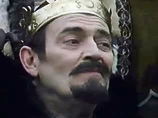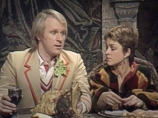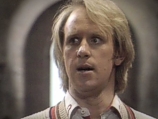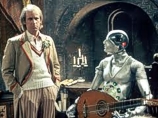 |
|
King John
|
|
 The date is 1215 and the Court of King John of England is at the castle of Sir Ranulf Fitzwilliam to extort more taxes, and when the lord refuses to pay the King insults him with his lack of generosity towards the crusade. To defend his honour his son Hugh takes on the King’s champion, Sir Gilles Estram, in a joust. The date is 1215 and the Court of King John of England is at the castle of Sir Ranulf Fitzwilliam to extort more taxes, and when the lord refuses to pay the King insults him with his lack of generosity towards the crusade. To defend his honour his son Hugh takes on the King’s champion, Sir Gilles Estram, in a joust.
 The following morning, villagers and knights gather to watch Hugh and Sir Gilles joust for the King’s honour. But the joust is disturbed by the arrival of the TARDIS. When they go outside The Doctor, mystified as to why the TARDIS has arrived at this place and time as he didn’t set those co-ordinates, and his travelling companions, Tegan Jovanka, and Vislor Turlough, are taken aback when they are greeted as demons and welcomed by the King. The following morning, villagers and knights gather to watch Hugh and Sir Gilles joust for the King’s honour. But the joust is disturbed by the arrival of the TARDIS. When they go outside The Doctor, mystified as to why the TARDIS has arrived at this place and time as he didn’t set those co-ordinates, and his travelling companions, Tegan Jovanka, and Vislor Turlough, are taken aback when they are greeted as demons and welcomed by the King.
 They watch the remainder of the joust, which Sir Gilles wins. The Doctor intercedes to plead for Hugh’s life, and the youth is spared. Everyone then returns to the castle, where Turlough becomes separated from The Doctor and Tegan. The Doctor thinks there is something afoot - King John is supposed to be in London at this time, taking the crusader’s oath. They watch the remainder of the joust, which Sir Gilles wins. The Doctor intercedes to plead for Hugh’s life, and the youth is spared. Everyone then returns to the castle, where Turlough becomes separated from The Doctor and Tegan. The Doctor thinks there is something afoot - King John is supposed to be in London at this time, taking the crusader’s oath.
 | | The Doctor and Tegan |
|
 Turlough is captured by a disgruntled Hugh - in sparing his life, The Doctor denied him honour - and taken to the dungeon. Sir Gilles likewise imprisons Ranulf’s wife, Lady Isabella, to ensure Ranulf’s good behaviour. He also has Hugh himself chained up alongside Turlough and Isabella. Meanwhile Ranulf decides to trust The Doctor and voices grave concerns about the King’s behaviour. The Doctor suggests that the King here is an impostor, but Ranulf finds this hard to believe. Turlough is captured by a disgruntled Hugh - in sparing his life, The Doctor denied him honour - and taken to the dungeon. Sir Gilles likewise imprisons Ranulf’s wife, Lady Isabella, to ensure Ranulf’s good behaviour. He also has Hugh himself chained up alongside Turlough and Isabella. Meanwhile Ranulf decides to trust The Doctor and voices grave concerns about the King’s behaviour. The Doctor suggests that the King here is an impostor, but Ranulf finds this hard to believe.
 Two riders then approach the castle and are met by Sir Gilles. The lead rider is Geoffrey de Lacey, just returned from attending the King in London. Sir Gilles has him taken prisoner. Two riders then approach the castle and are met by Sir Gilles. The lead rider is Geoffrey de Lacey, just returned from attending the King in London. Sir Gilles has him taken prisoner.
 | | The Doctor |
|
 At the next meal, the King plays the lute and sings a song in praise of war. Sir Gilles then brings in an iron maiden and prepares to have Geoffrey placed inside it. The Doctor again intercedes, claiming that Sir Gilles has behaved outrageously in even attempting to follow the King’s fine performance. Sir Gilles challenges The Doctor and they fight with swords. The Doctor wins, but Sir Gilles pulls out a familiar weapon and his face transforms into that of The Master. Tegan throws a knife at The Master, but he catches it and offers The Doctor the choice of weapons: the knife or his tissue compression eliminator. The Doctor snatches the eliminator but The Master merely laughs: he knows his adversary would never use it. The King then orders The Master placed in the iron maiden, and The Doctor is unable to prevent this. The Master is held inside the device and the door closed. At the next meal, the King plays the lute and sings a song in praise of war. Sir Gilles then brings in an iron maiden and prepares to have Geoffrey placed inside it. The Doctor again intercedes, claiming that Sir Gilles has behaved outrageously in even attempting to follow the King’s fine performance. Sir Gilles challenges The Doctor and they fight with swords. The Doctor wins, but Sir Gilles pulls out a familiar weapon and his face transforms into that of The Master. Tegan throws a knife at The Master, but he catches it and offers The Doctor the choice of weapons: the knife or his tissue compression eliminator. The Doctor snatches the eliminator but The Master merely laughs: he knows his adversary would never use it. The King then orders The Master placed in the iron maiden, and The Doctor is unable to prevent this. The Master is held inside the device and the door closed.
 Suddenly the iron maiden fades from sight - it was The Master’s TARDIS all along. After the King knights The Doctor, as his new champion, The Doctor then makes a pretence of placing Geoffrey under arrest in order to gain access to the dungeons. The Master gets there first, however, and releases Hugh and Isabella, claiming that The Doctor is plotting to topple the King from the throne. After they have gone, The Doctor arrives with Tegan and Geoffrey and releases Turlough. He also rigs up The Master’s eliminator at the back of the iron maiden. Suddenly the iron maiden fades from sight - it was The Master’s TARDIS all along. After the King knights The Doctor, as his new champion, The Doctor then makes a pretence of placing Geoffrey under arrest in order to gain access to the dungeons. The Master gets there first, however, and releases Hugh and Isabella, claiming that The Doctor is plotting to topple the King from the throne. After they have gone, The Doctor arrives with Tegan and Geoffrey and releases Turlough. He also rigs up The Master’s eliminator at the back of the iron maiden.
 The Master turns the whole castle against The Doctor and has Geoffrey shot in the back as he tries to leave for London to warn the real King. The Doctor and Tegan are captured, but Tegan gets inside The Doctor’s TARDIS and dematerialises it, allowing The Doctor to slip away in the confusion. The Master turns the whole castle against The Doctor and has Geoffrey shot in the back as he tries to leave for London to warn the real King. The Doctor and Tegan are captured, but Tegan gets inside The Doctor’s TARDIS and dematerialises it, allowing The Doctor to slip away in the confusion.
 | | The Doctor and Kamelion |
|
 The Doctor makes his way to the King’s chamber, where he finds a sophisticated android playing the lute and singing in the King’s voice. The Master appears and explains that he used the android Kamelion to escape from Xeriphas, the planet on which The Doctor trapped him at the end of their previous encounter. The tool of an earlier invader of Xeriphas, Kamelion was designed as a decoy weapon, capable of infinite form and personality, all controlled by concentration and psychokinetics. The Master is now using Kamelion to discredit King John and thereby ensure that the Magna Carta is not signed. The Doctor makes his way to the King’s chamber, where he finds a sophisticated android playing the lute and singing in the King’s voice. The Master appears and explains that he used the android Kamelion to escape from Xeriphas, the planet on which The Doctor trapped him at the end of their previous encounter. The tool of an earlier invader of Xeriphas, Kamelion was designed as a decoy weapon, capable of infinite form and personality, all controlled by concentration and psychokinetics. The Master is now using Kamelion to discredit King John and thereby ensure that the Magna Carta is not signed.
 Ranulf and his men burst into the King’s chamber and there ensues a battle of wills between The Master and The Doctor for control of Kamelion. This is won by The Doctor when Tegan materialises the TARDIS in the chamber, distracting The Master and the watching men. The Doctor, after causing Kamelion to adopt Tegan’s form, hustles the android and Turlough into the TARDIS. Ranulf and his men burst into the King’s chamber and there ensues a battle of wills between The Master and The Doctor for control of Kamelion. This is won by The Doctor when Tegan materialises the TARDIS in the chamber, distracting The Master and the watching men. The Doctor, after causing Kamelion to adopt Tegan’s form, hustles the android and Turlough into the TARDIS.
 The Master makes his escape in his own TARDIS, unaware that The Doctor’s tampering with the tissue compression eliminator will have affected its dimensional control. The Master makes his escape in his own TARDIS, unaware that The Doctor’s tampering with the tissue compression eliminator will have affected its dimensional control.
 Inside The Doctor’s TARDIS, Kamelion, who has a mind of his own, asks if he may travel with The Doctor. To Turlough’s surprise and Tegan’s dismay, The Doctor accepts Kamelion as a new travelling companion. After welcoming Kamelion aboard The Doctor sets the co-ordinates for the Eye of Orion. Inside The Doctor’s TARDIS, Kamelion, who has a mind of his own, asks if he may travel with The Doctor. To Turlough’s surprise and Tegan’s dismay, The Doctor accepts Kamelion as a new travelling companion. After welcoming Kamelion aboard The Doctor sets the co-ordinates for the Eye of Orion.
|